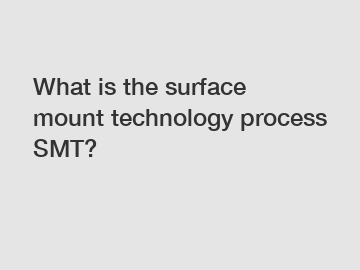What is the surface mount technology process SMT?
In today's fast-paced technological era, the demand for compact and high-performance electronic devices is constantly on the rise. To meet these requirements, manufacturers have adopted advanced manufacturing processes like Surface Mount Technology (SMT). This blog post aims to delve into the intricacies of the SMT process, explaining its significance and impact on modern electronics manufacturing.
What is Surface Mount Technology (SMT)?
Surface Mount Technology (SMT) is a method used to mount electronic components directly onto the surface of printed circuit boards (PCBs). Developed in the 1960s, SMT has become the industry standard for assembling electronic devices due to its superior efficiency and reliability compared to older through-hole assembly methods.

The SMT Process:
The SMT process involves a series of steps that ensure accurate and efficient assembly of components onto PCBs. Let's look at each stage in detail:
1. Design and Prototyping:
The journey begins with the design and prototyping phase, where engineers meticulously plan the circuit layout, component placement, and routing of traces on the PCB. This stage heavily relies on computer-aided design (CAD) software and simulation tools to optimize the design's functionality and manufacturability.
2. Stencil Creation:
Once the design is finalized, a stencil is created, usually made of stainless steel. This stencil acts as a guide, allowing precise deposition of solder paste onto the designated pads on the PCB surface. The solder paste acts as the adhesive agent that holds the components in place during subsequent stages.
3. Component Placement:
Using highly advanced pick-and-place machines, components are accurately placed onto the PCB's surface according to the specifications defined in the design. These machines employ computer-controlled robotic arms to handle and position components rapidly and precisely. The process involves placing tiny components like resistors, capacitors, integrated circuits (ICs), connectors, and more, with utmost precision.
4. Reflow Soldering:
After component placement, the PCB enters a reflow oven, where the entire assembly undergoes a carefully controlled thermal process. The oven's temperature is set to melt the solder paste, creating a strong bond between the components and the PCB's surface. The reflow process ensures reliable electrical connections while minimizing the risk of thermal or mechanical damage to the components.
5. Inspection and Testing:
Once the reflow process is complete, the PCB undergoes thorough inspection and testing to ensure the quality and functionality of the assembly. Automated optical inspection (AOI) systems, X-ray machines, and other testing methods scrutinize the solder joints, component placements, and trace integrity, leaving no room for errors.
Advantages of SMT:
Surface Mount Technology has several advantages over traditional through-hole technology, making it the go-to method for modern electronics manufacturing:
1. Miniaturization: SMT enables the placement of smaller components, resulting in more compact and lightweight devices.
2. Improved Performance: With shorter electrical paths, SMT reduces signal delays and interference, enhancing overall performance.
3. Higher Speed and Efficiency: The automated nature of the SMT process allows for quicker assembly, resulting in improved production rates and reduced labor costs.
4. Cost-Effective: SMT minimizes the material wastage, requires fewer drilled holes, and allows for multi-layered PCBs, reducing overall manufacturing costs.
5. Better Reliability: SMT's strong solder joints and automated inspection techniques ensure higher reliability and fewer chances of failure.
Conclusion:
Surface Mount Technology (SMT) has revolutionized the electronics manufacturing industry by providing a reliable, efficient, and cost-effective solution to meet the growing demand for advanced electronic devices. From design to assembly, SMT integrates various cutting-edge technologies, augments manufacturing speed, and reduces production costs. With its numerous advantages over traditional assembly methods, SMT has cemented its position as the backbone of modern electronic manufacturing, enabling the creation of innovative and highly functional devices that shape our interconnected world.
For more Pcb Smt Equipment, Identify Smd Capacitor, Vietnam Electronic Manufacturinginformation, please contact us. We will provide professional answers.

Comments
0